Eciton lucanoides
| Eciton lucanoides | |
|---|---|

| |
| Scientific classification | |
| Kingdom: | Animalia |
| Phylum: | Arthropoda |
| Class: | Insecta |
| Order: | Hymenoptera |
| Family: | Formicidae |
| Subfamily: | Dorylinae |
| Genus: | Eciton |
| Species: | E. lucanoides |
| Binomial name | |
| Eciton lucanoides Emery, 1894 | |
| Subspecies | |
| |
Photo Gallery
Identification
Minor worker: head, mesosoma, and metasoma evenly orange yellow or with some degree of reddish infuscation on mesosoma; occipital tooth present; petiolar teeth in the form of short, acute flanges, joined medially and forming a single median carina descending onto the posterior face, when viewed from the rear appearing as a Y-shaped structure; petiole long and low, subrectangular, or somewhat shortened and approaching the shape of burchellii; petiole never with anterodorsal elevated flange; fourth abdominal tergite with short, sparse appressed pubescence beneath erect setae.
Major worker: face densely micropunctate, matte; long sickle-shaped mandibles with broad tooth on inner margin at midlength; other characters as in minor.
Similar species: Eciton hamatum.
Distribution
Latitudinal Distribution Pattern
Latitudinal Range: 10.99261° to -12.921°.
| North Temperate |
North Subtropical |
Tropical | South Subtropical |
South Temperate |
- Source: AntMaps
Distribution based on Regional Taxon Lists
Neotropical Region: Bolivia, Brazil, Colombia, Costa Rica, Nicaragua, Peru (type locality).
Distribution based on AntMaps
Distribution based on AntWeb specimens
Check data from AntWeb
Countries Occupied
| Number of countries occupied by this species based on AntWiki Regional Taxon Lists. In general, fewer countries occupied indicates a narrower range, while more countries indicates a more widespread species. |

|
Estimated Abundance
| Relative abundance based on number of AntMaps records per species (this species within the purple bar). Fewer records (to the left) indicates a less abundant/encountered species while more records (to the right) indicates more abundant/encountered species. |

|
Biology
Jack Longino: This species occurs in mature wet forest throughout the Atlantic slope. Its highest density seems to be mid-elevation sites, but it can still be relatively abundant in the lowlands. At La Selva Biological Station it has a density similar to Eciton hamatum, with which it is often confused.
Raiding is always in columns, never in a carpet like Eciton burchellii. Raiding can be during the day or at night.
Brown & Fenner (1998) report this species conducting raids on the nests of Neoponera obscuricornis at La Selva, Costa Rica.
Association with Other Organisms
 Explore: Show all Associate data or Search these data. See also a list of all data tables or learn how data is managed.
Explore: Show all Associate data or Search these data. See also a list of all data tables or learn how data is managed.
- This species is a host for the phorid fly Apocephalus conecitonis (a parasite) (phorid.net) (attacked).
- This species is a host for the phorid fly Apocephalus pachycondylae (a parasite) (phorid.net) (attacked).
- This species is a associate (details unknown) for the phorid fly Ecitophora comes (a associate (details unknown)) (Quevillon, 2018).
- This species is a associate (details unknown) for the phorid fly Ecitophora costaricensis (a associate (details unknown)) (Quevillon, 2018).
- This species is a host for the phorid fly Diocophora duplexseta (a parasitoid) (Quevillon, 2018) (encounter mode primary; direct transmission; transmission outside nest).
Castes
- Worker
  
| |
| . | Owned by Museum of Comparative Zoology. |
- Soldier
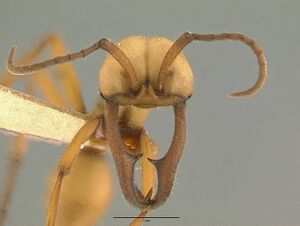 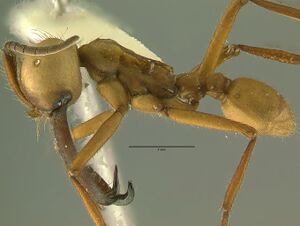 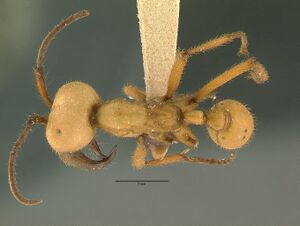
| |
| . | |
- Male
 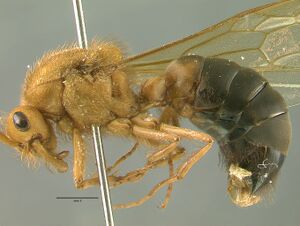 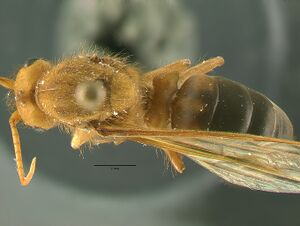
| |
| . | |
Images from AntWeb
   
| |
| Lectotype of Eciton lucanoides. Worker (major/soldier). Specimen code casent0903719. Photographer Z. Lieberman, uploaded by California Academy of Sciences. | Owned by MSNG, Genoa, Italy. |
     
| |
| Male (alate). Specimen code inbiocri001283561. Photographer Will Ericson, uploaded by California Academy of Sciences. | Owned by JTLC. |
Phylogeny
Relationships among species of Eciton based on Winston et al. (2016). The species Eciton jansoni, Eciton quadriglume, Eciton setigaster and Eciton uncinatum were not included in this study.
| Eciton |
| |||||||||||||||||||||||||||||||||||||||||||||||||||
Nomenclature
The following information is derived from Barry Bolton's Online Catalogue of the Ants of the World.
- lucanoides. Eciton lucanoides Emery, 1894c: 176, pl. 2, fig. 1 (s.) PERU.
- Type-material: 2 syntype workers.
- Type-locality: Peru: Cumbase (no collector’s name).
- Type-depository: MSNG.
- Combination in E. (Eciton): Emery, 1910b: 21.
- Status as species: Emery, 1900a: 186; Emery, 1910b: 21; Mann, 1916: 420; Borgmeier, 1923: 38; Borgmeier, 1936: 52; Borgmeier, 1955: 262 (redescription); Kempf, 1972a: 102; Watkins, 1976: 9 (in key); Bolton, 1995b: 185; Palacio, 1999: 152 (in key); Bezděčková, et al. 2015: 109; Palacio, 2019: 601.
- Distribution: Bolivia, Brazil, Colombia, Costa Rica, Nicaragua, Panama, Peru.
- Current subspecies: nominal plus conquistador.
Taxonomic Notes
Eciton lucanoides was described by Emery (1894) based on a soldier from Peru. Weber (1949) described Eciton lucanoides conquistador based on workers from Panama. Borgmeier (1955) made lucanoides conquistador a subspecies of lucanoides. Kempf (1972) listed the range of lucanoides as Peru, Bolivia, Brazil (Rondonia and Acre), Colombia, and the range of conquistador as Panama, Costa Rica, and Nicaragua. The males of these forms are unknown. Eciton jansoni was described by Forel (1912) based on a male from Nicaragua, and Kempf (1972) gives the range as Nicaragua, Costa Rica, Panama, Colombia, Ecuador.
By a process of elimination and geographic correspondence in Costa Rica, Eciton jansoni has to be the male of lucanoides conquistador. The males of the other Eciton species are known. Eciton jansoni males are very common in primary forest areas of the Atlantic slope, which is where E. l. conquistador is also common. Morphologically, there is a slight boss on the inner margin of the male mandible, perhaps corresponding to the pronounced tooth in the same position on the soldier.
Thus, if E. l. conquistador is distinct from E. lucanoides sensu stricto, then the Costa Rican species should be called E. jansoni, with E. l. conquistador a junior synonym. If it is not, then both are junior synonyms of E. lucanoides. Is E. l. conquistador really different from E. lucanoides senso stricto?
Borgmeier (1955) stated (my translation) "Eciton conquistador (the name is tacky) I regard as a subspecies of lucanoides. The differences from lucanoides are the following: the soldier of conquistador differs by the smaller head, the broad tooth on the inside of the mandible, the longer scape, the longer funiculus, the more raised and approximated lateral carinae of the propodeum, and the narrower petiole and postpetiole. The worker differs in the longer scape, the more raised and approximated lateral carinae of the propodeum, the strong central keel on the posterior face of the propodeum, and the narrower petiole." (I enjoyed Borgmeier's little editorial comment on Weber's name.) The range of E. jansoni approximately covers the range of both E. l. conquistador and E. lucanoides senso stricto, which suggests either that there is no difference in the males that corresponds to the worker subspecies or the differences are subtle and have not been discovered. More work is needed on character variation across the range of this lineage.
I have chosen to refer to the Costa Rican material as E. lucanoides, with the possibility that it may later change to E. jansoni.
Description
References
- Borgmeier, T. 1955. Die Wanderameisen der neotropischen Region. Stud. Entomol. 3: 1-720 (page 262, see also)
- Borowiec, M.L. 2019. Convergent evolution of the army ant syndrome and congruence in big-data phylogenetics. Systematic Biology 68, 642–656 (doi:10.1093/sysbio/syy088).
- Brown, B.V., Fenner, D.H. 1998. Parasitic phorid flies (Diptera: Phoridae) associated with army ants (Hymenoptera: Formicidae: Ecitoninae, Dorylinae) and their conservation biology. Biotropica 30: 482-487.
- Brückner, A., Hoenle, P.O., von Beeren, C. 2018. Comparative chemical analysis of army ant mandibular gland volatiles (Formicidae: Dorylinae). PeerJ 6, e5319 (doi:10.7717/peerj.5319).
- Emery, C. 1894d. Studi sulle formiche della fauna neotropica. VI-XVI. Bull. Soc. Entomol. Ital. 26: 137-241 (page 176, pl. 2, fig. 1 soldier described)
- Forel, A. 1912. Formicides néotropiques. Part I. Annales de la Société Entomologique de Belgique 56:28-49.
- Kempf, W. W. 1972. Catálogo abreviado das formigas da região Neotropical. Studia Entomologica 15:3-344.
- Mendoza-Guido, B., Rodríguez-Hernández, N., Ivens, A.B.F., von Beeren, C., Murillo-Cruz, C., Zuniga-Chaves, I., Łukasik, P., Sanchez, E., Kronauer, D.J.C., Pinto-Tomás, A.A. 2023. Low diversity and host specificity in the gut microbiome community of Eciton army ants (Hymenoptera: Formicidae: Dorylinae) in a Costa Rican rainforest. Myrmecological News 33: 19-34 (doi:10.25849/MYRMECOL.NEWS_033:019).
- Weber, N. A. 1949. A new Panama Eciton (Hymenoptera, Formicidae). American Museum Novitates 1441:1-8.
- Winston, M.E., Kronauer, D.J.C. & Moreau, C.S. 2016. Early and dynamic colonization of Central America drives speciation in Neotropical army ants. Molecular Ecology (doi: 10.1111/mec.13846).
References based on Global Ant Biodiversity Informatics
- Borgmeier T. 1953. Vorarbeiten zu einer Revision der neotropischen Wanderameisen. Studia Entomologica 2: 1-51.
- Borgmeier T. 1955. Die Wanderameisen der neotropischen Region. Studia Entomologica 3: 1-720.
- Borowiec M. L. 2016. Generic revision of the ant subfamily Dorylinae (Hymenoptera, Formicidae). ZooKeys 608: 1–280.
- Emery C. 1894. Studi sulle formiche della fauna neotropica. VI-XVI. Bullettino della Società Entomologica Italiana 26: 137-241.
- Emery C. 1900. Nuovi studi sul genere Eciton. Memorie della Reale Accademia delle Scienze dell'Istituto di Bologna (5)8: 173-188
- Emery C. 1910. Hymenoptera. Fam. Formicidae. Subfam. Dorylinae. Genera Insectorum 102: 1-34.
- Fernández F., E. E. Palacio, W. P. Mackay, and E. S. MacKay. 1996. Introducción al estudio de las hormigas (Hymenoptera: Formicidae) de Colombia. Pp. 349-412 in: Andrade M. G., G. Amat García, and F. Fernández. (eds.) 1996. Insectos de Colombia. Estudios escogidos. Bogotá: Academia Colombiana de Ciencias Exactas, Físicas y Naturales, 541 pp
- Fernández, F. and S. Sendoya. 2004. Lista de las hormigas neotropicales. Biota Colombiana Volume 5, Number 1.
- INBio Collection (via Gbif)
- Kempf, W.W. 1972. Catalago abreviado das formigas da regiao Neotropical (Hym. Formicidae) Studia Entomologica 15(1-4).
- Longino J. T. L., and M. G. Branstetter. 2018. The truncated bell: an enigmatic but pervasive elevational diversity pattern in Middle American ants. Ecography 41: 1-12.
- Longino J. et al. ADMAC project. Accessed on March 24th 2017 at https://sites.google.com/site/admacsite/
- Maes, J.-M. and W.P. MacKay. 1993. Catalogo de las hormigas (Hymenoptera: Formicidae) de Nicaragua. Revista Nicaraguense de Entomologia 23.
- Mann W. M. 1916. The Stanford Expedition to Brazil, 1911, John C. Branner, Director. The ants of Brazil. Bulletin of the Museum of Comparative Zoology 60: 399-490
- O'Donnell S., J. Lattke, S. Powell, and M. Kaspari. 2007. Army ants in four forests: geographic variation in raid rates and species composition. Journal of Animal Ecology 76: 580-589.
- Watkins J. F., II 1976. The identification and distribution of New World army ants (Dorylinae: Formicidae). Waco, Texas: Baylor University Press, 102 pp
- Pages using DynamicPageList3 parser function
- Photo Gallery
- Need species key
- Tropical
- Phorid fly Associate
- Host of Apocephalus conecitonis
- Host of Apocephalus pachycondylae
- Host of Ecitophora comes
- Host of Ecitophora costaricensis
- Host of Diocophora duplexseta
- Species
- Extant species
- Formicidae
- Dorylinae
- Eciton
- Eciton lucanoides
- Dorylinae species
- Eciton species
- Need Overview
- Need Body Text




